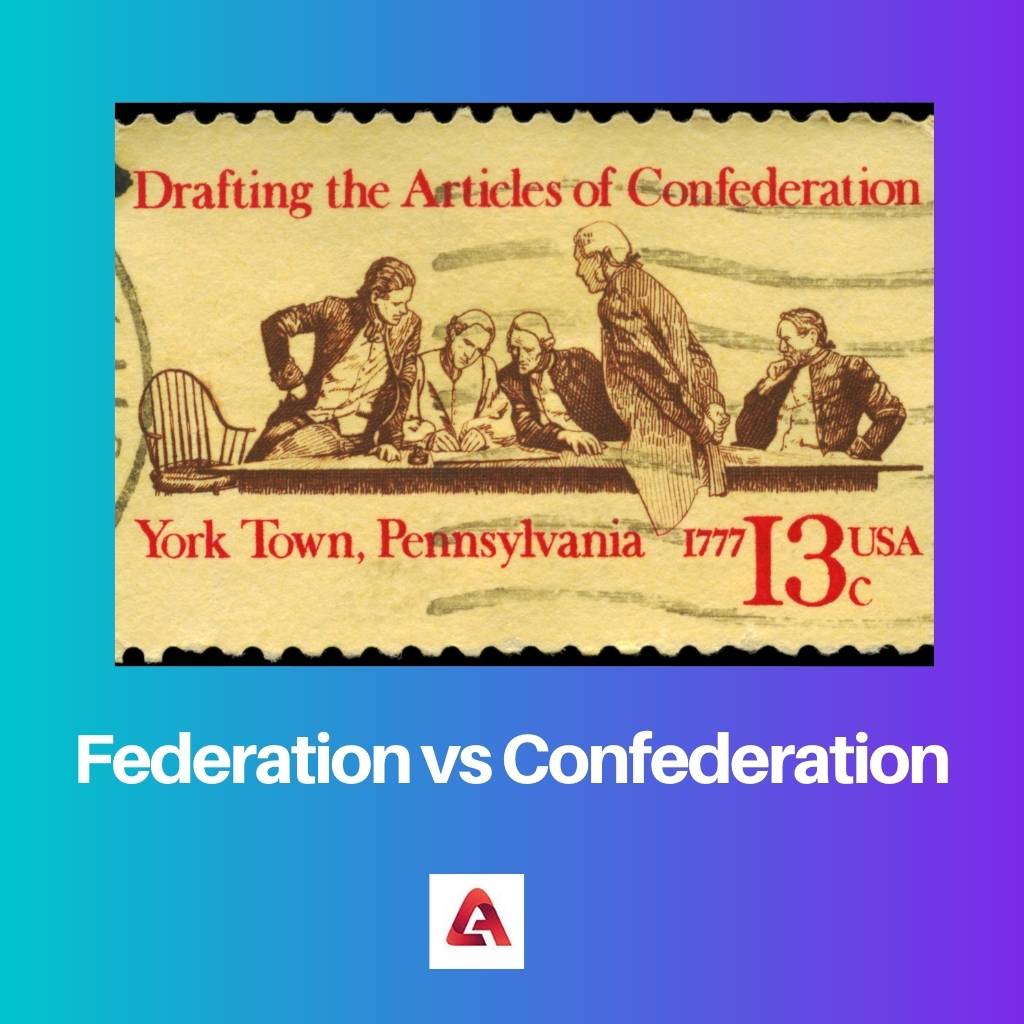A federation is a centralized system where power is shared between a central government and regional entities, with a written constitution delineating authority. In contrast, a confederation is a loose alliance of sovereign states with a weak central authority, where member states retain significant autonomy and can withdraw from the alliance.
Key Takeaways
- A federation is a political system in which power is shared between a central government and individual states or provinces.
- A confederation is a political system in which individual states or provinces hold power, and a central government has limited authority.
- A Federation is characterized by a strong central government, while a weak central government characterizes a confederation.
Federation vs Confederation
The difference between a federation and a confederation is that while the member states in the former submit their sovereignty to the federal government, the member states in the latter retain their sovereignty. The central government in a confederation is merely a figurehead organization. It remains accountable to the member states.

A confederation is a coalition of several sovereign states that reserve the right to secession. These composite units retain primary sovereignty. Unlike such a division of sovereign authority, a federal union reserves preliminary dominance over the quasi-sovereign member states.
Comparison Table
| Feature | Federation | Confederation |
|---|---|---|
| Central Government | Strong central government with significant power | Weak central government with limited power |
| Sovereignty of Members | Member states share some sovereignty with the central government | Member states retain most of their sovereignty |
| Lawmaking | Laws passed by the central government are binding on member states | Laws passed by the central government may require ratification by member states |
| Taxation | Central government has the power to levy taxes | Limited or no power to levy taxes centrally |
| Military | Central government controls the military | Military forces may remain under member state control |
| Membership | Difficult to leave the federation | Easier for member states to leave the confederation |
| Examples | United States, Canada, Germany | European Union (historically), The Arab League |
What is a Federation?
A federation is a form of government characterized by a central authority that shares power with constituent political units, such as states or provinces. This model is designed to balance the interests of different regions while maintaining a unified national identity. Federations are found in large, diverse countries where regional autonomy is valued.
Key Features of Federations
- Shared Powers: In a federation, powers are divided between the central government and regional entities. Certain responsibilities, such as defense, foreign affairs, and currency management, belong to the central government, while others, such as education, healthcare, and transportation, are managed at the regional level.
- Constitutional Framework: Federations operate under a written constitution that outlines the division of powers between the central government and regional entities. This constitution serves as the supreme law of the land and provides a framework for resolving conflicts between different levels of government.
- Dual Citizenship: Citizens of a federation hold dual citizenship, belonging to both the overarching nation and their specific region or state. This dual allegiance reflects the dual nature of federal governance, where individuals are subject to both central and regional laws.
- Supremacy Clause: Federations include a supremacy clause in their constitution, stating that federal law takes precedence over conflicting state or provincial laws. This ensures uniformity in certain areas of governance and prevents regional entities from undermining national interests.
Examples of Federations
- United States: The United States operates as a federal republic, with power divided between the federal government and individual states. The Constitution delineates the powers of the federal government and reserves all other powers to the states or the people.
- Canada: Canada is a federal state consisting of ten provinces and three territories, each with its own government and legislative authority. The Constitution Act of 1867 establishes the framework for federalism in Canada, outlining the division of powers between the federal government and provinces.
- Germany: Germany is a federal republic composed of 16 states, or Länder, each with its own government and legislative assembly. The Basic Law serves as Germany’s constitution and defines the distribution of powers between the federal government and states.

What is a Confederation?
A confederation is a political arrangement where sovereign states or regions form a loose alliance, retaining most of their autonomy while delegating limited powers to a central authority. Unlike federations, confederations emphasize the independence of member states and prioritize local control over centralized governance. Confederations are established to facilitate cooperation and mutual defense among independent entities.
Key Features of Confederations
- Sovereign States: In a confederation, member states retain their sovereignty and independence. They have the authority to govern themselves, including the power to enact laws, raise taxes, and engage in international relations. The central authority of the confederation is limited to specific areas, such as defense or trade.
- Weak Central Authority: Unlike federations, confederations have a decentralized structure with a weak central government. The central authority may be a confederal council or assembly composed of representatives from member states, but its powers are restricted to coordinating common interests and mediating disputes among members.
- Voluntary Participation: Participation in a confederation is voluntary, and member states can choose to withdraw from the alliance if they wish. This voluntary aspect reflects the principle of sovereignty and ensures that member states maintain control over their own affairs without interference from a dominant central authority.
- Limited Powers: The central authority of a confederation has limited powers, confined to matters of common interest, such as defense, foreign affairs, or trade regulation. Member states retain the majority of governmental functions, including the authority to manage internal affairs and enact laws within their borders.
Examples of Confederations
- Switzerland: Switzerland operates as a confederation composed of 26 cantons, each with its own constitution and government. The Swiss Confederation has a weak federal government, with most powers vested in the cantons. The federal government is responsible for defense, foreign relations, and certain aspects of national infrastructure.
- The Confederate States of America (1861-1865): During the American Civil War, the Confederate States of America formed a confederation of southern states that seceded from the United States. Each state retained its sovereignty, while a central government was established to coordinate defense and other common interests. However, this confederation was short-lived and dissolved after the Civil War.
- European Union (EU): The European Union can be considered a modern example of a confederation, although it exhibits characteristics of both confederal and federal systems. Member states of the EU retain significant sovereignty, with the EU central authority primarily responsible for areas such as trade policy, competition law, and monetary policy.

Main Differences Between Federation and Confederation
- Centralization of Power:
- Federation: Power is shared between a strong central government and regional entities, with the central government having significant authority over certain areas.
- Confederation: Power is decentralized, with member states retaining sovereignty and a weak central authority having limited powers delegated by the states.
- Constitutional Basis:
- Federation: Typically governed by a written constitution that delineates the division of powers between the central government and regional entities.
- Confederation: May lack a formal constitution or have a less rigid constitutional framework, with member states retaining more flexibility in governance.
- Voluntary Participation:
- Federation: Membership is compulsory and legally binding, with member states unable to unilaterally withdraw from the federation.
- Confederation: Participation is voluntary, and member states retain the right to withdraw from the alliance if they choose to do so.
- Degree of Sovereignty:
- Federation: Member states possess limited sovereignty compared to confederations, with the central government exercising authority over certain aspects of governance.
- Confederation: Member states retain significant sovereignty and autonomy, with the central authority having limited control over common interests.
- Supremacy of Law:
- Federation: Federal law supersedes conflicting state or provincial laws, ensuring uniformity and consistency in governance.
- Confederation: Member states’ laws may take precedence over central authority in certain cases, reflecting the principle of state sovereignty.
- Flexibility vs. Stability:
- Federation: Offers a balance between central control and regional autonomy, providing stability and consistency in governance.
- Confederation: Emphasizes flexibility and diversity, allowing member states to pursue their own policies and priorities within the confederal framework.
- https://books.google.com/books?hl=en&lr=&id=nT8YpGSGDcIC&oi=fnd&pg=PA45&dq=federation+vs+confederation&ots=mUNGvptgsP&sig=uQNzwiuvxge4Qsmf9vbTF0eELHk
- http://sam.gov.tr/pdf/perceptions/Volume-IV/september-november-1999/CLEMENT-H.-DODD.pdf